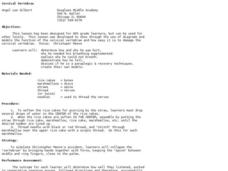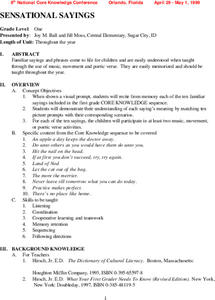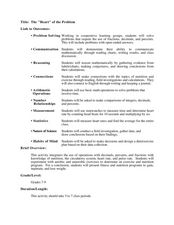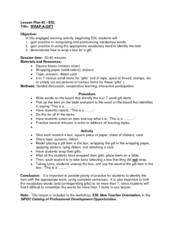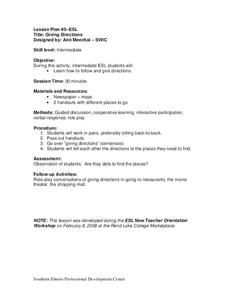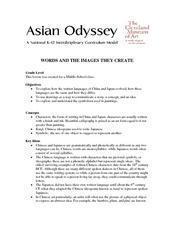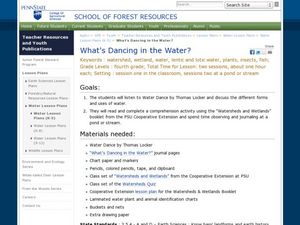Curated OER
Cervical Vertebrae
Eighth graders investigate the cervical vertebrae through models and diagrams. In this cervical vertebrae lesson plan, 8th graders use rice cakes, straws, marshmallows and thread to model the vertebrae. They simulate a cervical vertebrae...
Curated OER
Making Sense of the Reformation in 1 Day
Ninth graders explore the events of the Protestant Reformation. in this religious denominations instructional activity, 9th graders use the provided graphic organizer to take notes on a PowerPoint presentation about the different beliefs...
Curated OER
Importance of the Rain Forest
Students use the Internet to conduct a research project. In this rain forest lesson, students work in groups to research different parts of the rain forest. Students research climate, foods, house products and...
Curated OER
Making an Illustrated Dictionary with Geographic Terms
Students construct a geography dictionary. In this geography lesson, students work in small groups to construct a dictionary of geographic terms. Students use illustrations and descriptions to develop their geographic dictionaries.
Curated OER
Ramona Quimby, Age 8
Third graders read Beverly Cleary's book "Ramona Quimby, Age 8" and then complete a series of extension activities. Students explore cause and effect, sequencing, related websites, grammar lessons and comparison skills.
Curated OER
Life in Ancient Mesopotamia
Students reconstruct and make drawings of vessels in the same manner as an archaeologist. In this archaeologist lesson plan, students each get a piece of a broken pot and they have to work together to put it back together. Once it is...
Curated OER
Now Hear This!
Students create a model of the inner ear. In this hearing lesson, students follow a series of directions to build a working model of the inner ear, then observe how the parts react to a variety of sounds.
Curated OER
Sensational Sayings
Students recognize and interpret the meaning of proverbs and saying through music, poetry and movement. In this familiar sayings lesson, students participate in various games and activities to gain understanding of the meanings of...
Curated OER
The "Heart" of the Problem
Students explore mathematical operations while studying nutrition. In this physical fitness lesson, students explore calories, pulse rate, and the circulatory system. Students use mathematical data to create a healthy physical fitness...
Curated OER
Wrap a Gift
With wrapping a gift as the focus, this lesson has learners practice vocabulary and formulating descriptions. They wrap and unwrap a gift identifying the objects as they go. This activity could be enhanced to make it a richer experience.
Curated OER
Integer Addition
Seventh graders explore the concept of integer addition. In this integer addition lesson, 7th graders tell stories involving addition and subtraction. Students walk on a number line given directions such as add 3 or add -2. Students play...
Curated OER
Giving Directions
While incomplete, this lesson provides an interesting way to approach an activity on giving and following directions. Learners work in groups, using a newspaper and maps, to give each other directions to a specific location. The handouts...
Curated OER
Simplify Expression Using the Order of Operations
Allow learners to explore both the right and wrong way of completing equations with the order of operations. They discuss how the order in which operations are performed affects the outcome of a problem. A fun "trick" using order of...
Curated OER
The Medium And The Message
Learners compare and contrast Buddhist sculpture in varying materials through in-class discussions and small cooperative learning groups. This lesson includes possible lesson extensions.
Curated OER
The Role Of Japanese Women
Students consider the role of women in upper-class Japanese society through the reading of a folktale and the study of Japanese art images. The activity emphasizes small, cooperative learning groups.
Curated OER
Gifts From China To The West
High schoolers identify Chinese inventions that are widely used today and explore how
these inventions influenced social development in the West in this Social Studies lesson using cooperative learning techniques.
Curated OER
Sixth Graders Express Themselves
Sixth graders create examples of expressionistic paintings using pastels, black paper, and chalk in this 6th grade Art lesson. Emphasis is on creating an emotion for the painting using simple lines and large shapes and cooperative...
Curated OER
Travels Of A Florida Migrant Child
Middle schoolers discuss the story Amelia's Road by Vickie Leigh Krudwig in this cross-curricular Math lesson for the middle-level classroom. Elements of the social sciences are addressed. Cooperative learning groups are suggested for...
Curated OER
Words And the Images They Create
Students explore how the written languages of China and Japan evolved, creating representations of Chinese and Japanese Poetry. Emphasis is placed on small, cooperative learning groups.
Curated OER
Love and Friendship
Third graders do a hands-on activity after being read aloud the story of The Rag Coat, in cooperative groups.
Curated OER
Creating a Classroom Belief Statement
Fourth graders cooperatively develop a classroom belief statement that serves as their classroom constitution. Each student is involved in the creation of the statement. Each group presents their belief statement to the class.
Curated OER
What are Numbers?: Learning to Add
Students identify numbers from 0-20. They show quantities to 20. Students work in small groups and take pictures of items demonstrating the numbers that they have beeen taught. They form the number shape using their bodies and take...
Curated OER
What's Dancing in the Water?
Students learn about watershed, as well as the different forms and uses of water. In this water forms lesson, students brainstorm water sources and uses. Students read the book Water Dance and discuss water examples. Students complete a...
Curated OER
The Polymer Schoolhouse
Students study various objects and determine plastic and non-plastic. For this creative lesson students get into groups and create a diorama to show the different properties they discovered.
